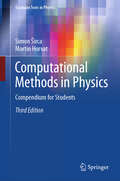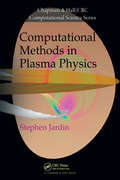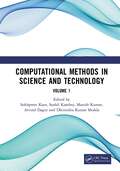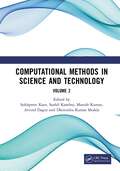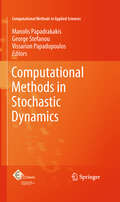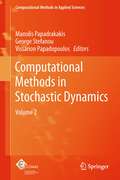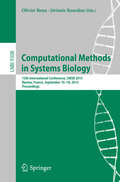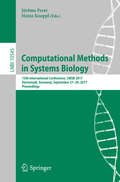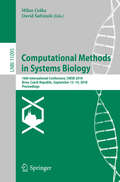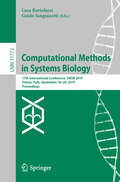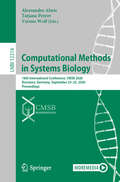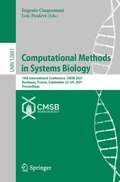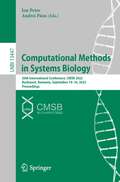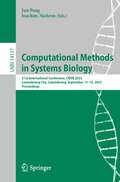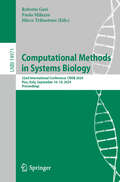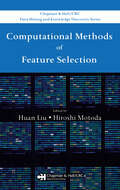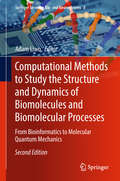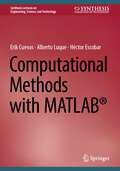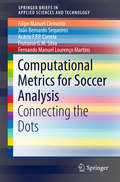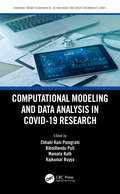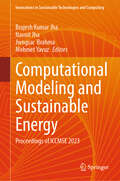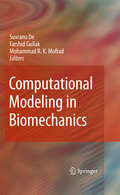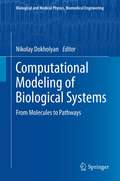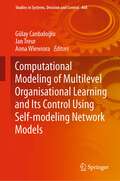- Table View
- List View
Computational Methods in Physics: Compendium for Students (Graduate Texts in Physics)
by Martin Horvat Simon ŠircaThis textbook provides a compendium of numerical methods to assist physics students and researchers in their daily work. It carefully considers error estimates, stability and convergence issues, the choice of optimal methods, and techniques to increase program execution speeds. The book supplies numerous examples throughout the chapters that are concluded by more comprehensive problems with a strong physics background. Instead of uncritically employing modern black-box tools, the readers are encouraged to develop a more ponderous and skeptical approach. This revised and expanded edition now includes a new chapter on numerical integration and stable differentiation, as well as fresh material on optimal filtering, integration of gravitational many-body problems, computation of Poincaré maps, regularization of orbits, singular Sturm-Liouville problems, techniques for time evolution and spatial treatment of (semi)infinite domains in spectral methods, and phase retrieval. It also brings updated discussions of algebraic problems involving sparse matrices and of high-resolution schemes for partial differential equations.
Computational Methods in Plasma Physics (Chapman & Hall/CRC Computational Science)
by Stephen JardinAssuming no prior knowledge of plasma physics or numerical methods, Computational Methods in Plasma Physics covers the computational mathematics and techniques needed to simulate magnetically confined plasmas in modern magnetic fusion experiments and future magnetic fusion reactors. Largely self-contained, the text presents the basic concepts neces
Computational Methods in Science and Technology: Proceedings of the 4th International Conference on Computational Methods in Science & Technology (ICCMST 2024), 2–3 May 2024, Mohali, India, Volume 1
by Manish Kumar Arvind Dagur Dhirendra Kumar Shukla Sukhpreet Kaur Sushil KambojThis book contains the proceedings of the 4TH International Conference on Computational Methods in Science and Technology (ICCMST 2024).The proceedings explores research and innovation in the field of Internet of things, Cloud Computing, Machine Learning, Networks, System Design and Methodologies, Big Data Analytics and Applications, ICT for Sustainable Environment, Artificial Intelligence and it provides real time assistance and security for advanced stage learners, researchers and academicians has been presented.This will be a valuable read to researchers, academicians, undergraduate students, postgraduate students, and professionals within the fields of Computer Science, Sustainability and Artificial Intelligence.
Computational Methods in Science and Technology: Proceedings of the 4th International Conference on Computational Methods in Science & Technology (ICCMST 2024), 2–3 May 2024, Mohali, India, Volume 2
by Manish Kumar Arvind Dagur Dhirendra Kumar Shukla Sukhpreet Kaur Sushil KambojThis book contains the proceedings of the 4TH International Conference on Computational Methods in Science and Technology (ICCMST 2024).The proceedings explores research and innovation in the field of Internet of things, Cloud Computing, Machine Learning, Networks, System Design and Methodologies, Big Data Analytics and Applications, ICT for Sustainable Environment, Artificial Intelligence and it provides real time assistance and security for advanced stage learners, researchers and academicians has been presented.This will be a valuable read to researchers, academicians, undergraduate students, postgraduate students, and professionals within the fields of Computer Science, Sustainability and Artificial Intelligence.
Computational Methods in Stochastic Dynamics: Volume 2 (Computational Methods in Applied Sciences #22)
by Manolis Papadrakakis George Stefanou Vissarion PapadopoulosAt the dawn of the 21st century, computational stochastic dynamics is an emerging research frontier. This book focuses on advanced computational methods and software tools which can highly assist in tackling complex problems in stochastic dynamic/seismic analysis and design of structures. The book is primarily intended for researchers and post-graduate students in the fields of computational mechanics and stochastic structural dynamics. Nevertheless, practice engineers as well could benefit from it as most code provisions tend to incorporate probabilistic concepts in the analysis and design of structures. The book addresses mathematical and numerical issues in stochastic structural dynamics and connects them to real-world applications. It consists of 16 chapters dealing with recent advances in a wide range of related topics (dynamic response variability and reliability of stochastic systems, risk assessment, stochastic simulation of earthquake ground motions, efficient solvers for the analysis of stochastic systems, dynamic stability, stochastic modelling of heterogeneous materials). Numerical examples demonstrating the significance of the proposed methods are presented in each chapter.
Computational Methods in Stochastic Dynamics: Volume 2 (Computational Methods in Applied Sciences #26)
by Manolis Papadrakakis George Stefanou Vissarion PapadopoulosThe considerable influence of inherent uncertainties on structural behavior has led the engineering community to recognize the importance of a stochastic approach to structural problems. Issues related to uncertainty quantification and its influence on the reliability of the computational models are continuously gaining in significance. In particular, the problems of dynamic response analysis and reliability assessment of structures with uncertain system and excitation parameters have been the subject of continuous research over the last two decades as a result of the increasing availability of powerful computing resources and technology. This book is a follow up of a previous book with the same subject (ISBN 978-90-481-9986-0) and focuses on advanced computational methods and software tools which can highly assist in tackling complex problems in stochastic dynamic/seismic analysis and design of structures. The selected chapters are authored by some of the most active scholars in their respective areas and represent some of the most recent developments in this field. The book consists of 21 chapters which can be grouped into several thematic topics including dynamic analysis of stochastic systems, reliability-based design, structural control and health monitoring, model updating, system identification, wave propagation in random media, seismic fragility analysis and damage assessment. This edited book is primarily intended for researchers and post-graduate students who are familiar with the fundamentals and wish to study or to advance the state of the art on a particular topic in the field of computational stochastic structural dynamics. Nevertheless, practicing engineers could benefit as well from it as most code provisions tend to incorporate probabilistic concepts in the analysis and design of structures.
Computational Methods in Systems Biology: 13th International Conference, CMSB 2015, Nantes, France, September 16-18, 2015, Proceedings (Lecture Notes in Computer Science #9308)
by Olivier Roux Jérémie BourdonThis book constitutes the refereed proceedings of the 13th International Conference on Computational Methods in Systems Biology, CMSB 2015, held in Nantes, France, in September 2015. The 20 full papers and 2 short papers presented were carefully reviewed and selected from 43 full and 4 short paper submissions. The papers cover a wide range of topics in the analysis of biological systems, networks and data such as model checking, stochastic analysis, hybrid systems, circadian clock, time series data, logic programming, and constraints solving ranging from intercellular to multiscale.
Computational Methods in Systems Biology: 15th International Conference, CMSB 2017, Darmstadt, Germany, September 27–29, 2017, Proceedings (Lecture Notes in Computer Science #10545)
by Heinz Koeppl Jérôme FeretThis book constitutes the refereed proceedings of the 15th International Conference on Computational Methods in Systems Biology, CMSB 2017, held in Darmstadt, Germany, in September 2017. The 15 full papers, 4 tool papers and 4 posters presented together with 1 invited talk were carefully reviewed and selected from 41 regular paper submissions. Topics of interest include formalisms for modeling biological processes; models and their biological applications; frameworks for model verication, validation, analysis, and simulation of biological systems; high-performance computational systems biology and parallel implementations; model inference from experimental data; model integration from biological databases; multi-scale modeling and analysis methods; and computational approaches for synthetic biology.
Computational Methods in Systems Biology: 16th International Conference, CMSB 2018, Brno, Czech Republic, September 12-14, 2018, Proceedings (Lecture Notes in Computer Science #11095)
by David Šafránek Milan ČeškaThis book constitutes the refereed proceedings of the 16th International Conference on Computational Methods in Systems Biology, CMSB 2018, held in BRNO, Czech Republic, in September 2018. The 15 full and 7 short papers presented together with 5 invited talks were carefully reviewed and selected from 46 submissions. Topics of interest include formalisms for modeling biological processes; models and their biological applications; frameworks for model verification, validation, analysis, and simulation of biological systems; high-performance computational systems biology; parameter and model inference from experimental data; automated parameter and model synthesis; model integration and biological databases; multi-scale modeling and analysis methods; design, analysis, and verification methods for synthetic biology; methods for biomolecular computing and engineered molecular devices.Chapters 3, 9 and 10 are available open access under a Creative Commons Attribution 4.0 International License via link.springer.com.
Computational Methods in Systems Biology: 17th International Conference, CMSB 2019, Trieste, Italy, September 18–20, 2019, Proceedings (Lecture Notes in Computer Science #11773)
by Guido Sanguinetti Luca BortolussiThis book constitutes the refereed proceedings of the 17th International Conference on Computational Methods in Systems Biology, CMSB 2019, held in Trieste, Italy, in September 2019.The 14 full papers, 7 tool papers and 11 posters were carefully reviewed and selected from 53 submissions. Topics of interest include formalisms for modeling biological processes; models and their biological applications; frameworks for model verification, validation, analysis, and simulation of biological systems; high-performance computational systems biology and parallel implementations; model inference from experimental data; model integration from biological databases; multi-scale modeling and analysis methods; computational approaches for synthetic biology; and case studies in systems and synthetic biology.
Computational Methods in Systems Biology: 18th International Conference, CMSB 2020, Konstanz, Germany, September 23–25, 2020, Proceedings (Lecture Notes in Computer Science #12314)
by Alessandro Abate Verena Wolf Tatjana PetrovThis book constitutes the refereed proceedings of the 18th International Conference on Computational Methods in Systems Biology, CMSB 2020, held in Konstanz, Germany, in September 2020.*The 17 full papers and 5 tool papers were carefully reviewed and selected from 30 submissions. In addition 3 abstracts of invited talks and 2 tutorials have been included in this volume. Topics of interest include formalisms for modeling biological processes; models and their biological applications; frameworks for model verification, validation, analysis, and simulation of biological systems; high-performance computational systems biology and parallel implementations; model inference from experimental data; model integration from biological databases; multi-scale modeling and analysis methods; computational approaches for synthetic biology; and case studies in systems and synthetic biology. * The conference was held virtually due to the COVID-19 pandemic.
Computational Methods in Systems Biology: 19th International Conference, CMSB 2021, Bordeaux, France, September 22–24, 2021, Proceedings (Lecture Notes in Computer Science #12881)
by Eugenio Cinquemani Loïc PaulevéThis book constitutes the refereed proceedings of the 19th International Conference on Computational Methods in Systems Biology, CMSB 2021, held in Bordeaux, France, September 22–24, 2021.*The 13 full papers and 5 tool papers were carefully reviewed and selected from 32 submissions. The topics of interest include biological process modelling; biological system model verification, validation, analysis, and simulation; high-performance computational systems biology; model inference from experimental data; multi-scale modeling and analysis methods; computational approaches for synthetic biology; machine learning and data-driven approaches; microbial ecology modelling and analysis; methods and protocols for populations and their variability; models, applications, and case studies in systems and synthetic biology. The chapters "Microbial Community Decision Making Models in Batch", "Population design for synthetic gene circuits", "BioFVM-X: An MPI+OpenMP 3-D Simulator for Biological Systems" are published open access under a CC BY license (Creative Commons Attribution 4.0 International License). * The conference was held in a hybrid mode due to the COVID-19 pandemic.
Computational Methods in Systems Biology: 20th International Conference, CMSB 2022, Bucharest, Romania, September 14–16, 2022, Proceedings (Lecture Notes in Computer Science #13447)
by Ion Petre Andrei PăunThis book constitutes the refereed proceedings of the 20th International Conference on Computational Methods in Systems Biology, CMSB 2022, held in Bucharest, Romania, in September 2022.The 13 full papers and 4 tool papers were carefully reviewed and selected from 43 submissions. CMSB focuses on modeling, simulation, analysis, design and control of biological systems. The papers are arranged thematically as follows: Chemical reaction networks; Boolean networks; continuous and hybrid models; machine learning; software.
Computational Methods in Systems Biology: 21st International Conference, CMSB 2023, Luxembourg City, Luxembourg, September 13–15, 2023, Proceedings (Lecture Notes in Computer Science #14137)
by Jun Pang Joachim NiehrenThis book constitutes the refereed proceedings of the 21st International Conference on Computational Methods in Systems Biology, CMSB 2023, held in Luxembourg City, Luxembourg, during September 13–15, 2023. The 14 full papers and 3 tool papers presented in this book were carefully reviewed and selected from 28 submissions. CMSB focuses on modeling, simulation, analysis, design and control of biological systems and covers the broad field of computational methods and tools in systems and synthetic biology and their applications.
Computational Methods in Systems Biology: 22nd International Conference, CMSB 2024, Pisa, Italy, September 16–18, 2024, Proceedings (Lecture Notes in Computer Science #14971)
by Paolo Milazzo Mirco Tribastone Roberta GoriThis book constitutes the refereed proceedings of the 22nd International Conference on Computational Methods in Systems Biology, CMSB 2024, which took place in Pisa, Italy, during September 16-18, 2024. The 11 full papers included in this book were carefully reviewed and selected from 23 submissions. They deal with computational methods and tools in systems and synthetic biology and their applications, focusing on topics such as modeling and simulation; high-performance methods for computational systems biology; identification of biological systems; applications of machine learning; network modeling, analysis, and inference; automated parameter and model synthesis; model integration and biological databases; multiscale modeling and analysis methods; design, analysis, and verification methods for synthetic biology; methods for biomolecular computing and engineered molecular devices; data-based approaches for systems and synthetic biology; optimality and control of biological systems; modeling, analysis, and control of microbial communities. The conference welcomes new theoretical results with potential applications to systems and synthetic biology, as well as novel applications and case studies of existing methods, tools, or frameworks.
Computational Methods of Feature Selection (Chapman & Hall/CRC Data Mining and Knowledge Discovery Series)
by Huan Liu Hiroshi MotodaDue to increasing demands for dimensionality reduction, research on feature selection has deeply and widely expanded into many fields, including computational statistics, pattern recognition, machine learning, data mining, and knowledge discovery. Highlighting current research issues, Computational Methods of Feature Selection introduces the
Computational Methods to Study the Structure and Dynamics of Biomolecules and Biomolecular Processes: From Bioinformatics to Molecular Quantum Mechanics (Springer Series on Bio- and Neurosystems #8)
by Adam LiwoThis book provides a comprehensive overview of modern computer-based techniques for analyzing the structure, properties and dynamics of biomolecules and biomolecular processes. It is organized in four main parts; the first one deals with methodology of molecular simulations; the second one with applications of molecular simulations; the third one introduces bioinformatics methods and the use of experimental information in molecular simulations; the last part reports on selected applications of molecular quantum mechanics. This second edition has been thoroughly revised and updated to include the latest progresses made in the respective field of research.
Computational Methods with MATLAB® (Synthesis Lectures on Engineering, Science, and Technology)
by Erik Cuevas Alberto Luque Héctor EscobarThis textbook provides readers a comprehensive introduction to numerical methods, using MATLAB®. The authors discuss the theory and application of the most often used numerical methods, using MATLAB as a computational tool. The book is designed to be accessible to readers of varying backgrounds, so the presentation focuses more on the description, implementation, and application of the methods and less on the mathematical details. This book not only covers the most important methods and techniques of scientific computation, but also contains a great amount of code and implementations, facilitating the process of learning and application.
Computational Metrics for Soccer Analysis: Connecting the dots (SpringerBriefs in Applied Sciences and Technology)
by Filipe Manuel Clemente João Bernardo Sequeiros Acácio F. P. P. Correia Frutuoso G. M. Silva Fernando Manuel Lourenço MartinsThis book provides an account of the use of computational tactical metrics in improving sports analysis, in particular the use of Global Positioning System (GPS) data in soccer. As well as offering a practical perspective on collective behavioural analysis, it introduces the computational metrics available in the literature that allow readers to identify collective behaviour and patterns of play in team sports. These metrics only require the bio-dimensional geo-referencing information from GPS or video-tracking systems to provide qualitative and quantitative information about the tactical behaviour of players and the inter-relationships between teammates and their opponents. Exercises, experimental cases and algorithms enable readers to fully comprehend how to compute these metrics, as well as introducing them to the ultimate performance analysis tool, which is the basis to run them on. The script to compute the metrics is presented in Python. The book is a valuable resource for professional analysts as well students and researchers in the field of sports analysis wanting to optimise the use of GPS trackers in soccer.
Computational Modeling and Data Analysis in COVID-19 Research (Emerging Trends in Biomedical Technologies and Health informatics)
by Chhabi Rani Panigrahi, Bibudhendu Pati, Mamata Rath and Rajkumar BuyyaThis book covers recent research on the COVID-19 pandemic. It includes the analysis, implementation, usage, and proposed ideas and models with architecture to handle the COVID-19 outbreak. Using advanced technologies such as artificial intelligence (AI) and machine learning (ML), techniques for data analysis, this book will be helpful to mitigate exposure and ensure public health. We know prevention is better than cure, so by using several ML techniques, researchers can try to predict the disease in its early stage and develop more effective medications and treatments. Computational technologies in areas like AI, ML, Internet of Things (IoT), and drone technologies underlie a range of applications that can be developed and utilized for this purpose. Because in most cases there is no one solution to stop the spreading of pandemic diseases, and the integration of several tools and tactics are needed. Many successful applications of AI, ML, IoT, and drone technologies already exist, including systems that analyze past data to predict and conclude some useful information for controlling the spread of COVID-19 infections using minimum resources. The AI and ML approach can be helpful to design different models to give a predictive solution for mitigating infection and preventing larger outbreaks. This book: Examines the use of artificial intelligence (AI), machine learning (ML), Internet of Things (IoT), and drone technologies as a helpful predictive solution for controlling infection of COVID-19 Covers recent research related to the COVID-19 pandemic and includes the analysis, implementation, usage, and proposed ideas and models with architecture to handle a pandemic outbreak Examines the performance, implementation, architecture, and techniques of different analytical and statistical models related to COVID-19 Includes different case studies on COVID-19 Dr. Chhabi Rani Panigrahi is Assistant Professor in the Department of Computer Science at Rama Devi Women’s University, Bhubaneswar, India. Dr. Bibudhendu Pati is Associate Professor and Head of the Department of Computer Science at Rama Devi Women’s University, Bhubaneswar, India. Dr. Mamata Rath is Assistant Professor in the School of Management (Information Technology) at Birla Global University, Bhubaneswar, India. Prof. Rajkumar Buyya is a Redmond Barry Distinguished Professor and Director of the Cloud Computing and Distributed Systems (CLOUDS) Laboratory at the University of Melbourne, Australia.
Computational Modeling and Sustainable Energy: Proceedings of ICCMSE 2023 (Innovations in Sustainable Technologies and Computing)
by Brajesh Kumar Jha Navnit Jha Jwngsar Brahma Mehmet YavuzThis book features best-selected research papers presented at International Conference on Computational Modeling and Sustainable Energy (ICCMSE 2023) held at Pandit Deendayal Energy University, Gandhinagar, Gujarat, India, during December 15–17, 2023. It comprises high-quality research work by academicians and industrial experts in the field of machine learning, mobile computing, natural language processing, fuzzy computing, green computing, human–computer interaction, information retrieval, intelligent control, data mining and knowledge discovery, evolutionary computing, big data, cloud computing, business intelligence, Internet security, pattern recognition, and sustainable energy.
Computational Modeling in Biomechanics
by Suvranu De Farshid Guilak Mohammad MofradAvailability of advanced computational technology has fundamentally altered the investigative paradigm in the field of biomechanics. Armed with sophisticated computational tools, researchers are seeking answers to fundamental questions by exploring complex biomechanical phenomena at the molecular, cellular, tissue and organ levels. The computational armamentarium includes such diverse tools as the ab initio quantum mechanical and molecular dynamics methods at the atomistic scales and the finite element, boundary element, meshfree as well as immersed boundary and lattice-Boltzmann methods at the continuum scales. Multiscale methods that link various scales are also being developed. While most applications require forward analysis, e.g., finding deformations and stresses as a result of loading, others involve determination of constitutive parameters based on tissue imaging and inverse analysis. This book provides a glimpse of the diverse and important roles that modern computational technology is playing in various areas of biomechanics including biofluids and mass transfer, cardiovascular mechanics, musculoskeletal mechanics, soft tissue mechanics, and biomolecular mechanics.
Computational Modeling of Biological Systems: From Molecules to Pathways (Biological and Medical Physics, Biomedical Engineering)
by Nikolay V DokholyanComputational modeling is emerging as a powerful new approach to study and manipulate biological systems. Multiple methods have been developed to model, visualize, and rationally alter systems at various length scales, starting from molecular modeling and design at atomic resolution to cellular pathways modeling and analysis. Higher time and length scale processes, such as molecular evolution, have also greatly benefited from new breeds of computational approaches. This book provides an overview of the established computational methods used for modeling biologically and medically relevant systems.
Computational Modeling of Cognition and Behavior
by Simon Farrell Stephan LewandowskyComputational modeling is now ubiquitous in psychology, and researchers who are not modelers may find it increasingly difficult to follow the theoretical developments in their field. This book presents an integrated framework for the development and application of models in psychology and related disciplines. Researchers and students are given the knowledge and tools to interpret models published in their area, as well as to develop, fit, and test their own models. Both the development of models and key features of any model are covered, as are the applications of models in a variety of domains across the behavioural sciences. A number of chapters are devoted to fitting models using maximum likelihood and Bayesian estimation, including fitting hierarchical and mixture models. Model comparison is described as a core philosophy of scientific inference, and the use of models to understand theories and advance scientific discourse is explained. Covers both basic and advanced topics to appeal to students and researchers alike. Provides a framework for using models in a variety of domains across psychology and related disciplines. Describes the application of models by walking through code written in R, a popular and free statistical programming language
Computational Modeling of Multilevel Organisational Learning and Its Control Using Self-modeling Network Models (Studies in Systems, Decision and Control #468)
by Jan Treur Gülay Canbaloğlu Anna WiewioraAlthough there is much literature on organisational learning, mathematical formalisation and computational simulation, there is no literature that uses mathematical modelling and simulation to represent and explore different facets of multilevel learning. This book provides an overview of recent work on mathematical formalisation and computational simulation of multilevel organisational learning by exploiting the possibilities of self-modeling network models to address it. This is the first book addressing mathematical formalisation and computational modeling of multilevel organisational learning in a systematic, principled manner. A self-modeling network modeling approach from AI and Network Science is used where in a reflective manner some of the network nodes (called self-model nodes) represent parts of the network’s own network structure characteristics. This is supported by a dedicated software environment allowing to design and implement (higher-order) adaptive network models by specifying them in a conceptual manner at a high level of abstraction in a standard table format, without any need of algorithmic specification or programming. This modeling approach allows to model the development of knowledge in an organisational setting in a neatly structured manner at three different levels for the usage, adaptation and control, respectively, of the underlying mental models. Several examples of realistic cases of multilevel organisational learning are used to illustrate the approach. Crucial concepts such as the aggregation of mental models to form shared mental models out of individual mental models are addressed extensively. It is shown how to model context-sensitive control of organisational learning taking into account a wide variety of context factors, for example relating to levels of expertise of individuals or to leadership styles of managers involved. Mathematical equilibrium analysis of models of organisational learning is also addressed, among others allowing verification of correctness of the implemental models in comparison to their conceptual design. Chapters in this book also contribute to the Management and Business Sciences research by demonstrating how computational modeling can be used to capture complex management phenomena such as multilevel organizational learning. This book has a potential implication for practice by demonstrating how computational modeling can be used to capture learning scenarios, which then provide a basis for more informed managerial decisions.
